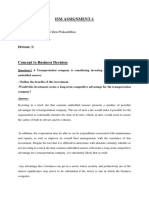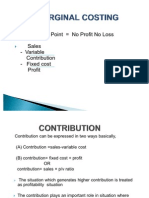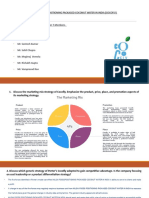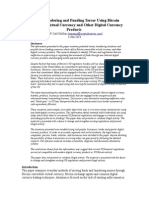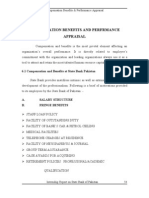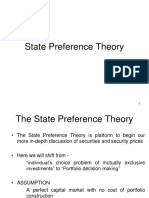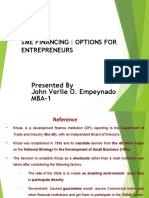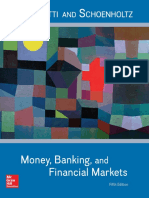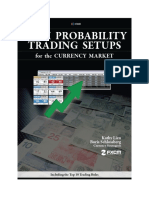Capital Budgeting Sums-Doc For PDF (Encrypted)
Capital Budgeting Sums-Doc For PDF (Encrypted)
Uploaded by
Prasad GharatCopyright:
Available Formats
Capital Budgeting Sums-Doc For PDF (Encrypted)
Capital Budgeting Sums-Doc For PDF (Encrypted)
Uploaded by
Prasad GharatOriginal Title
Copyright
Available Formats
Share this document
Did you find this document useful?
Is this content inappropriate?
Copyright:
Available Formats
Capital Budgeting Sums-Doc For PDF (Encrypted)
Capital Budgeting Sums-Doc For PDF (Encrypted)
Uploaded by
Prasad GharatCopyright:
Available Formats
Sem II | Financial Management | 2020-21
CAPITAL BUDGETING UNDER CERTAINTY
General Steps for Capital Budgeting
1. Calculation of Initial Cash Outflow (ignore sunk cost)
Cost of Initial investment/replacement/capital rationing
+ Working Capital requirement/ Investment
- Salvage Value of Old Machine
+ (Salvage Value of old Machine-Book Value of old machine) * (Tax Rate)
(refers to any gains or losses realized on the sale of older equipment. For instance, if an old piece of
machinery is sold for more than its book value, the company will realize a capital gain and thus be
charged taxes on this gain. Conversely, if the piece of machinery is sold for less than its book value, the
company will experience a loss but also a tax benefit.)
2. Calculation of depreciation, Book value and salvage value.
3. Determination of Relevant and Incremental Operating Cash Inflow after tax
(Include opportunity cost & externalities like cannibalization; Exclude Financing/ Interest cost as it is
considered in discounting factor)
4. Determination of Terminal Cash Inflow.
PAT
+ Depreciation & Non-cash expense
+Release of net working capital
+Salvage Value realized on disposal of asset
- (Salvage Value of new Machine-Book Value of new machine) * (Tax Rate)
(adding the tax saving due to loss on sale of machine since SV < BV; subtracting tax paid on due to profit
on sale of machine since SV>BV)
5. Decide technique/method of capital budgeting to be used.
A. Non-discounted Cash Flow Criteria
Payback Period (PB)
Accounting Rate of Return (ARR)
B. Discounted Cash Flow (DCF) Criteria
Net Present Value (NPV)
Internal Rate of Return (IRR)
Profitability Index (PI)
Discounted payback period (DPB)
6. Recommendation/Final Decision based on Accept-reject rule of the selected method
Techniques of Capital Budgeting Acceptance Rule, IF
Payback Period (PB) PB < life of project
Discounted payback period (DPB) DPB < life of project
Accounting Rate of Return (ARR) ARR > WACC
Net Present Value (NPV) NPV > 0
Profitability Index (PI) PI > 1
Internal Rate of Return (IRR) IRR > WACC
Compiled by Prof. Khushboo Vora
Sem II | Financial Management | 2020-21
Capital Budgeting Techniques
Non-discounted Cash flow Criteria Discounted Cash flow Criteria
Payback Period (PB) Net Present Value (NPV)
Accounting Rate of Return Internal Rate of Return
(ARR) (IRR)
Profitability Index (PI)
Discounted payback period
(DPB)
CASELETS
1. Super Dairy Limited (STL) is planning to buy dairy equipment costing Rs 400 lacs. Milk
Board provides 10% subsidy on the capital cost. It can process milk to produce cheese with
the capacity of 1,80,000 kg per annum. The selling price of cheese is taken as Rs 500 per Kg.
The management expects the life of the plant at 8 years and the depreciation policy is SLM.
However, the plant can be sold at Rs 80 lacs at the end of its useful life. The utilization of
plant is expected as below:
Years 1 2 3 4 to 7 8
Capacity utilization 60% 70% 80% 90% 100%
The variable cost constituting primarily of the raw material, milk is placed at 40% while the
fixed expenses are Rs 300 lacs per annum. The firm pays 50% tax. The additional working
capital required is Rs 100 lacs.
Find the following:
a) Cash flows of the project from Year 0 to Year 8 (-460,24,59,86,113,113,113,113,320)
b) Compute NPV and PI of the project @ 13% (20.36, 1.04)
c) Compute IRR of the project (13.95)
d) Payback period and discounted payback period (5yrs 6.09months; 7yrs 9.96 months)
Compiled by Prof. Khushboo Vora
Sem II | Financial Management | 2020-21
2. A fashion clothing company is considering investing in new machinery to improve its
productivity over the next 5 years. You have been given the following information:
Sales are predicted to increase by Rs15 lakhs in year 1 and continue at this level.
The new machinery costs Rs100 lakhs payable immediately.
It will be depreciated over 5 years on a straight line basis.
All the old machinery can be sold for Rs20 lakhs. Its book value as on today is Rs 19
lakhs and depreciation amount charged yearly was Rs 5,00,000.
The new equipment is more complicated and will cost Rs1,60,000 per year every
year to maintain, as against the Rs1,00,000 for the old machines, but other running
costs will be reduced by Rs120,000.
Finance for the purchase needs to be raised via a loan which requires annual
interest payments of Rs3,00,000.
Wages will be reduced by Rs1,00,000 due to increased automation.
At the end of the five years the machinery will have a scrap value of Rs 25 lakhs.
The feasibility study for this project cost Rs2 lakhs.
The hurdle rate on investment appraisal for this level of risk is 8.5%.
Identify which of these items would be included in an NPV calculation and calculate the
NPV. You may ignore tax and inflation. (NPV 8204079.41, PI 1.03) Will your answer change if
tax is 35%. (NPV -741208.911, PI 0.91)
3. The Gilbert Instrument Corporation is considering replacing the wood steamer it
currently uses to shape guitar sides. The steamer has 6 years of remaining life. If kept, the
steamer will have depreciation expenses of Rs 650 for 5 years and Rs 325 for the sixth year.
Its current book value is Rs 3,575 and it can be sold for on an internet auction sit for Rs 4150
at this time. If the old steamer is not replaced, it can be sold for Rs 800 at the end of its useful
life.
Gilbert Instrument Corporation is considering purchasing the “Side Steamer 3000”, a high-
end steamer, which costs Rs 12000 and has an estimated useful life of 6 years with an
estimated salvage value of Rs 1500. The steamer will be depreciated using WDV method @
25%. The new steamer is faster and allows an output expansion, so sales would rise by Rs
2000 per year; the new machine’s much greater efficiency would reduce operating expenses
by Rs 1900 per year. To support the greater sales, the new machine would require that
inventories increase by Rs 2900, but accounts payable would simultaneously increase by Rs
700. Gilbert Instrument Corporation’s marginal tax rate is 40% and its WACC is 15%. Should
it replace the old steamer? (NPV 1919.13, IRR 21.26%, PI 1.19)
Compiled by Prof. Khushboo Vora
Sem II | Financial Management | 2020-21
4. Lotus Corporation is contemplating replacement of its existing milling machine with an
improved version that would increase the production from 12,000 components per month
to 18,000. Due to improved design the new component would also fetch a better price of Rs
90 as against existing price of Rs 85 per piece.
New machine costs Rs 120 lacs with additional amount on installation and training
of Rs 15 lacs to be spent. If purchased, the existing milling machine would be sold for Rs 3.5
lacs that has a book value of Rs 4 lacs. The remaining life of the existing machine is 5 years
and the firm follows a policy of SLM for depreciation of fixed assets. The life of the new
machine too is 5 years
Installation of new machine would entail some extra recurring cost. The operator
salary would be increased from Rs 50,000 to Rs 70,000 per month. However, it would save
the cost on maintenance and power. While the production would increase by 50% the rise
in maintenance cost would be 20% from existing Rs 10,000 per month. Similarly, the power
consumption would increase by 25% only from existing Rs 6,000 per month. There would
be no change in any other cost. Increase in working capital may be ignored.
Assuming 40% taxes and cost of capital at 10% examine whether Lotus Corporation should
buy the new milling machine or not. (yes NPV= 6577542.26 PI=1.5, IRR=28.13%)
5. Calmex is situated in North India. It specializes in manufacturing overhead water tanks.
The management of Calmex has identified a niche market in certain Southern cities that need
a particular size of water tank, not currently manufactured by the company. The company is
therefore thinking of producing a new type of overhead water tank. The survey of the
company’s marketing department reveals that the company could sell 1,20,000 tanks each
year for six years at a price of Rs 700 each. The company’s current facilities cannot be used
to manufacture the new-size tanks. Therefore, it will have to buy new machinery. A
manufacturer has offered two options to the company. The first option is that the company
could buy four small machines with the capacity of manufacturing 30,000 tanks each at Rs
15milliom each. The machine operation and manufacturing cost of each tank will be Rs 535.
Alternatively, Calmex can buy a larger machine with a capacity of 1,20,000 units per annum
for Rs 120 million. The machine operation and manufacturing cost of each tank will be Rs
400. The company has a required rate of return of 12%. Assume that the company does not
pay any taxes.
Which option should the company accept? Use the most suitable method of evaluation to
give your recommendation and explicitly state your assumptions. Why do you think that the
method chosen by you is the most suitable method in evaluating the proposed investment?
Give the computation of the alternative methods. (Option 1: NPV 21.40, IRR 23.86%; Option 2:
NPV 28.01, IRR 19.91%; Incremental NPV 6.60, IRR 15.81%)
Compiled by Prof. Khushboo Vora
Sem II | Financial Management | 2020-21
6. GSPC is a fast growing profitable company. The company is situated in Western India. Its
sales are expected to grow about three times from Rs 360 million in 2019 to Rs 1100 million
in 2020. The company is considering of commissioning a 35 km pipeline between to areas
to carry gas to a state electricity board. The project will cost Rs 250 million. The pipeline will
have a capacity of 2.5 MMSCM. The company will enter into a contract with the State
Electricity board (SEB) to supply gas. The revenue from the sale to SEB is expected to be Rs
120 million per annum. The pipeline will also be used for transportation of LNG to other
users in the area. This is expected to bring additional revenue of Rs 80 million per annum.
The company management considers the useful life of the pipeline to be 20 years. The
financial manager estimates cash profit to sales ratio of 20% per annum for the first 12 years
of the project operation and 17% per annum for the remaining life of the project. The project
has no salvage value. The project being in backward are is exempt from paying any taxes.
The company’s hurdle rate is 15% from the project.
a) What is the project’s payback and discounted payback period? (6+, 20+)
b) What is the project’s Return on Investment? (Average Rate of Return) (30.08%)
c) Compute project’s NPV, PI and IRR (-4.65902, 0.981, 14.65%)
d) Should the project be accepted? Why?
7. Computea Ltd is a company based in Delhi. It is into outsourcing IT consulting and systems
integration. Setup as a startup company three year ago by 5 entrepreneurs, the headcount
of the company is presently 100, with an annual turnover of Rs 80 lakh. As an employee
friendly organisation and to ensure good working environment, Computea Ltd arranges
tea/coffee to each of its employees thrice a day. About half of the employees prefer tea and
remaining half prefer coffee. Tea and coffee are presently supplied by a vendor who is paid
on a monthly basis. The cost of a cup of tea is Rs 10. The cost of coffee is Rs 15 per cup. Labour
charges amount to Rs 500 per month.
The HR manager, K V Prasad, has proposed to the CEO, Vineet Barnwal, to install a coffee/tea
vending machine in the premises of computea Ltd. A vending machine is available from Good
Serve Ltd for Rs 3.5 Lakh having a useful life of 5 years with no salvage value. The machine
would require an annual maintenance cost of Rs 60,000 (i.e. 5000 per month) in addition to
spare parts amounting to Rs 10,000. The operating of the vending machine would consume
electricity of Rs 1500 per month. The other associated operating costs would be as estimated
below.
2 packets of coffee beans per day at Rs 500 per packet
2 packets of 1 kg tea powder per day at Rs 400 per packet
7500 plastic cups per month at Rs 0.50 per cup.
200 litres of milk per month (A litre of milk cost Rs 70)
60 kgs of sugar per month (The price of sugar is Rs 35 per Kg)
Labour charges would amount to Rs 1500 per month
The number of working days in a month are 23. Computea Ltd would use SLM for
depreciation and its cost of capital is 10%. As a financial consultant, would you advice the
CEO of Computea Ltd to install the Vending Machine? Why? Assume tax 35%.
Compiled by Prof. Khushboo Vora
Sem II | Financial Management | 2020-21
HOME ASSIGNMENT
A. Pay Early Ltd is planning a major investment to expand its current manufacturing of
digital clocks with initial cash outlay of Rs 350 Lakh. The next finance department has
projected a following cash flow over the next 7 years considered to be the life of the project:
Years 0 1 2 3 4 5 6 7
Cash flow Rs Lakh -350 100 150 400 450 300 250 50
(a) What is the payback period of the project? (2 years 3 months)
(b) What is the discounted payback period assuming discounting is done at 15%? (2yrs 6.83
mnths)
B. Smart Manufacturing Company is planning to reduce its labor costs by automating a
critical task that is currently performed manually. The automation requires the installation
of a new machine. The cost to purchase and install a new machine is Rs15,000. The
installation of machine can reduce annual labor cost by Rs 4,200. The life of the machine is
15 years. The salvage value of the machine after fifteen years will be zero. The required rate
of return of Smart Manufacturing Company is 25%.
Should Smart Manufacturing Company purchase the machine? (Yes NPV 1,208)
C. Project M is under consideration for selection. Its initial Cash Outlay is Rs 1800 and life of
5 years. The cost of capital of the firm is 12%.
Years 0 1 2 3 4 5
Cash flow Rs Lakh -1800 600 300 1000 800 1100
(a) What is the payback period of the project? (2 years 10.8 months)
(b) If the cut off payback period is 3 years, should the project be accepted? (Yes)
(c) What is the discounted payback period of the project? (3yrs 7.40 mnths)
(d) If the cut off payback period is 3 years even on discounted basis, should the project be
accepted (no)
D. Project X & Project Y costs Rs 50,000 and Rs YEAR CASH INFLOWS
25,000 respectively. Their cash flows are given Project X (Rs) Project Y (Rs)
below. You are required to find out the internal 1 5,000 10,000
rate of return for each project and decide on the 2 15,000 10,000
basis which project is more profitable. 3 30,000 10,000
(16.37%, 28.64%) 4 20,000 10,000
5 10,000 10,000
E. A firm is considering purchase of 100 sewing machines. Each of the machine cost Rs 180
and would yield a cash flow of Rs 5,300 for next five years. If the cost of capital for the firm
is 14% find the following:
(a) NPV of the project (195.33)
(b) Profitability Index of the project (1.0109)
(c) Calculate Payback and Discounted Payback period (3yrs 7.24 mnths; 4 years 11 mnths)
Compiled by Prof. Khushboo Vora
Sem II | Financial Management | 2020-21
F. Machining Products Limited (MPL) is planning to purchase a CNC Lathe costing Rs 220
lacs. It has an estimated life of 10 years with salvage value of Rs 20 lacs. Over a period of 10
years MPL expects a profit before tax after depreciation of Rs 30 lacs every year. It pays a
tax of 35% and charges depreciation on SLM basis. Find out whether MPL should buy CNC
machine if the cost of capital for them is 12%. Ignore changes in working capital. Present
value of annuity for 10 years at 12.00% = PVAF (12.00%, 10) = 5.6502; Present value of Re
1 after 10 years at 12.00% = PVF (12.% , 10) = 0.3220.
(a) Calculate NPV (9.62)
(b) Calculate PI (1.0437)
(C) IRR
(d) Discounted payback period
G. B Company is evaluating a proposal to acquire an automated welding machine for its small
parts assembly department. The equipment costs Rs 6,80,000 + 5% sales tax on the purchase
and spend Rs 20,000 for freight and installation. The equipment has a useful life of 10 years
and is expected to produce cost savings of Rs 1,57,500 per year. There is no salvage value.
Company policy is not to fund any capital project whose internal rate of return is below the
company’s 16% cost of capital. Should the company invest in this project? (hint: Calculate
Internal rate of return) (16.9%)
Compiled by Prof. Khushboo Vora
You might also like
- Animal HealthDocument3 pagesAnimal Healthkritigupta.may1999No ratings yet
- Ism Assignment 1Document9 pagesIsm Assignment 1Bhargavi RathodNo ratings yet
- Zillow's Q4 2021 Shareholder LetterDocument20 pagesZillow's Q4 2021 Shareholder LetterGeekWireNo ratings yet
- Linear ProgrammingDocument27 pagesLinear ProgrammingBerkshire Hathway cold100% (1)
- FM - Assignment Batch 19 - 21 IMS IndoreDocument3 pagesFM - Assignment Batch 19 - 21 IMS IndoreaskjdfaNo ratings yet
- Ratio Analysis of Tata SteelDocument11 pagesRatio Analysis of Tata SteelUtkarsh GuptaNo ratings yet
- Continuous Assignments: Ram Kumar KakaniDocument10 pagesContinuous Assignments: Ram Kumar KakaniKabeer KarnaniNo ratings yet
- TESLA-financial Statement 2016-2020Document18 pagesTESLA-financial Statement 2016-2020XienaNo ratings yet
- Numericals On Cost of Capital and Capital StructureDocument2 pagesNumericals On Cost of Capital and Capital StructurePatrick AnthonyNo ratings yet
- Duration: 2 Hours Total Marks: 30 Term-II Instructions: All Questions Are CompulsaryDocument13 pagesDuration: 2 Hours Total Marks: 30 Term-II Instructions: All Questions Are CompulsaryAdiNo ratings yet
- Toyota Case-Class 3Document5 pagesToyota Case-Class 3Sravani Reddy BodduNo ratings yet
- Financial Management CIA-1.2Document9 pagesFinancial Management CIA-1.2arnav chandnaNo ratings yet
- Mini CaseDocument15 pagesMini CaseSammir Malhotra0% (1)
- Pricing Strategy Report - Group 5 - Maruti BalenoDocument19 pagesPricing Strategy Report - Group 5 - Maruti BalenodwnpiyushNo ratings yet
- Appendix - 8A The Maturity ModelDocument10 pagesAppendix - 8A The Maturity ModelAndreea IoanaNo ratings yet
- Valuation of Goods and Services Under GSTDocument22 pagesValuation of Goods and Services Under GSTReshmith FFNo ratings yet
- Break Even Point No Profit No Loss Sales - Variable Contribution - Fixed Cost ProfitDocument10 pagesBreak Even Point No Profit No Loss Sales - Variable Contribution - Fixed Cost ProfitShilpan ShahNo ratings yet
- STCBL Financial AnalysisDocument33 pagesSTCBL Financial AnalysisSonam K Gyamtsho67% (3)
- Project Presentation ON " An Analysis of Capital Structure For Hindustan Unilever Limited."Document14 pagesProject Presentation ON " An Analysis of Capital Structure For Hindustan Unilever Limited."Raja Sekar0% (1)
- Fund Based ActivitiesDocument35 pagesFund Based Activitiesyaminipawar509100% (3)
- Infosys Ratio AnalysisDocument61 pagesInfosys Ratio AnalysisGaurav Bhalgat0% (1)
- Case US-64 ControversyDocument4 pagesCase US-64 ControversyBiweshNo ratings yet
- Cost Analysis of Coca-Cola Company - by HakimzadDocument18 pagesCost Analysis of Coca-Cola Company - by HakimzadHakimzad9001 Faisal9001100% (1)
- Working Capital MGTDocument14 pagesWorking Capital MGTrupaliNo ratings yet
- B2B - Notes by ShreyashDocument20 pagesB2B - Notes by Shreyashdreament8No ratings yet
- Goa Sahakar BhandarDocument18 pagesGoa Sahakar BhandarSimon Alan Correia100% (1)
- Financial Management at Bajaj AutoDocument8 pagesFinancial Management at Bajaj AutoNavin KumarNo ratings yet
- MAC Costing ReportDocument10 pagesMAC Costing ReportRohanNo ratings yet
- Financial Management Cia3Document9 pagesFinancial Management Cia3Prince ChaudharyNo ratings yet
- 2.2-Module 2 Only QuestionsDocument46 pages2.2-Module 2 Only QuestionsHetviNo ratings yet
- A Case Study On Process Costing System of Uniliver (BD) Limited-Chap-1-13Document30 pagesA Case Study On Process Costing System of Uniliver (BD) Limited-Chap-1-13Jehan MahmudNo ratings yet
- Marginal CostingDocument80 pagesMarginal CostingParamjit Sharma96% (25)
- Factors Affecting Valuation of SharesDocument6 pagesFactors Affecting Valuation of SharesSneha ChavanNo ratings yet
- LeverageDocument7 pagesLeverageChiranjeev RoutrayNo ratings yet
- Lesson 1 Introduction To Law and The Meaning and EssentialsDocument201 pagesLesson 1 Introduction To Law and The Meaning and EssentialsSandip Dankhara100% (2)
- Cost of Capital ExcelDocument9 pagesCost of Capital ExcelBlossom KaurNo ratings yet
- Internship Offer Letter: Krishna GolyanDocument5 pagesInternship Offer Letter: Krishna GolyanKrishna GolyanNo ratings yet
- Retail Shopper BehaviourDocument204 pagesRetail Shopper BehaviourBhava Rotaract100% (1)
- FM Reliance IndustriesDocument30 pagesFM Reliance IndustriesAkshata Masurkar100% (2)
- Market Structure of Indian IT Industry-InFOSYSDocument20 pagesMarket Structure of Indian IT Industry-InFOSYSNitin ChidarNo ratings yet
- Model ProjectDocument62 pagesModel ProjectpradeepNo ratings yet
- Case 1Document18 pagesCase 1Amit Kanti RoyNo ratings yet
- IFM - Problem On BopDocument6 pagesIFM - Problem On BopSatya KumarNo ratings yet
- The Japanese ModelDocument3 pagesThe Japanese ModelSiva Prasad PasupuletiNo ratings yet
- A ReportDocument53 pagesA ReportImnoneNo ratings yet
- Finance Aptitude QuestionsDocument11 pagesFinance Aptitude QuestionssugamNo ratings yet
- Step # 1: Calculation of Installment For BorrowingDocument5 pagesStep # 1: Calculation of Installment For BorrowingSyed HammadNo ratings yet
- Finance DossierDocument108 pagesFinance DossierAbhishek VarshneyNo ratings yet
- By-Harsh Patel (b1019)Document11 pagesBy-Harsh Patel (b1019)harshNo ratings yet
- ACFrOgA8B1 AXdvFTvs9j3EM24DahDYIcJzmeVabGUoqlt8xCvhCtozvckYFaqz3P4WJYXOuEu DVmJqZeUF HFF KuUpHKzSp2Ff c9FeMgmMQstd 2g0oW6kOjXdcDocument3 pagesACFrOgA8B1 AXdvFTvs9j3EM24DahDYIcJzmeVabGUoqlt8xCvhCtozvckYFaqz3P4WJYXOuEu DVmJqZeUF HFF KuUpHKzSp2Ff c9FeMgmMQstd 2g0oW6kOjXdcFrancis MFANo ratings yet
- HDFC Bank MisDocument15 pagesHDFC Bank MisPooja PanchalNo ratings yet
- Dabur India - Working Capital and Cost ManagementDocument15 pagesDabur India - Working Capital and Cost ManagementhiteshvNo ratings yet
- CHP 3. Process Costing Sums (1st Batch)Document36 pagesCHP 3. Process Costing Sums (1st Batch)Uchit MehtaNo ratings yet
- Tata Motors:cost of CapitalDocument10 pagesTata Motors:cost of CapitalAnkit GuptaNo ratings yet
- Capital Budgeting - NotesDocument171 pagesCapital Budgeting - NotesSiddharth mehtaNo ratings yet
- EABD Question BankDocument4 pagesEABD Question BankVENKATESH TELANGNo ratings yet
- Case Study - Nilgai Foods: Positioning Packaged Coconut Water in India (Cocofly)Document6 pagesCase Study - Nilgai Foods: Positioning Packaged Coconut Water in India (Cocofly)prathmesh kulkarniNo ratings yet
- SWOT Analysis of Royal EnfieldDocument6 pagesSWOT Analysis of Royal Enfieldpramodsravan100% (1)
- Sidbi & Sidc: Presentation OnDocument20 pagesSidbi & Sidc: Presentation OnNageshwar MishraNo ratings yet
- Financial Statements of Banking Companies: © The Institute of Chartered Accountants of IndiaDocument44 pagesFinancial Statements of Banking Companies: © The Institute of Chartered Accountants of IndiaHarikrishnaNo ratings yet
- Cost Of Capital A Complete Guide - 2020 EditionFrom EverandCost Of Capital A Complete Guide - 2020 EditionRating: 4 out of 5 stars4/5 (1)
- Dividend Decisions-Ppt (Encrypted)Document30 pagesDividend Decisions-Ppt (Encrypted)Prasad GharatNo ratings yet
- Sources of Finance: Financial ManagementDocument8 pagesSources of Finance: Financial ManagementPrasad GharatNo ratings yet
- Cost of Capital-2021-Ppt (Encrypted)Document26 pagesCost of Capital-2021-Ppt (Encrypted)Prasad GharatNo ratings yet
- BCG Matrix IllustrationDocument4 pagesBCG Matrix IllustrationPrasad GharatNo ratings yet
- Body Language - What Is It-Revised 2020Document223 pagesBody Language - What Is It-Revised 2020Prasad GharatNo ratings yet
- Insurance - Fire PolicyDocument4 pagesInsurance - Fire PolicyPrasad GharatNo ratings yet
- Balance Sheet For The Year Ending 31st March 2019 2020 Capital and LiabilitiesDocument1 pageBalance Sheet For The Year Ending 31st March 2019 2020 Capital and LiabilitiesPrasad GharatNo ratings yet
- Intro-Communication Skills-R-2020Document437 pagesIntro-Communication Skills-R-2020Prasad GharatNo ratings yet
- Financial Statement Exercise - Ravi TextilesDocument2 pagesFinancial Statement Exercise - Ravi TextilesPrasad GharatNo ratings yet
- Digital Marketing: - Prof. Rashmi JainDocument60 pagesDigital Marketing: - Prof. Rashmi JainPrasad GharatNo ratings yet
- Personality PPT 2015-17Document40 pagesPersonality PPT 2015-17Prasad GharatNo ratings yet
- Affective Events TheoryDocument1 pageAffective Events TheoryPrasad GharatNo ratings yet
- Cpa Review School of The Philippines ManDocument15 pagesCpa Review School of The Philippines ManHeart EspineliNo ratings yet
- Insurance Dataset Description2Document4 pagesInsurance Dataset Description2Siddhesh TiwariNo ratings yet
- Account Activity Generated Through HBL MobileDocument1 pageAccount Activity Generated Through HBL MobileMustafa KhanNo ratings yet
- Finance Essay On Superdry FINALDocument9 pagesFinance Essay On Superdry FINALJude OlaoluwaNo ratings yet
- Money Laundering and Funding Terror Using Bitcoin Convertible Virtual Currency and Other Digital Currency ProductsDocument40 pagesMoney Laundering and Funding Terror Using Bitcoin Convertible Virtual Currency and Other Digital Currency ProductsCarl MullanNo ratings yet
- Policy 19743223 23012021Document7 pagesPolicy 19743223 23012021Lallu KalluNo ratings yet
- (IBF301) - International Finance SyllabusDocument2 pages(IBF301) - International Finance SyllabusSu NgNo ratings yet
- RTFDocument51 pagesRTFkalidindi_kc_krishnaNo ratings yet
- Compensation and Benefits at State Bank PakistanDocument11 pagesCompensation and Benefits at State Bank PakistanRehma Salman33% (3)
- Con N: RulingDocument38 pagesCon N: Rulingstunner_1994No ratings yet
- North South University: Manufacturing of The Pen HolderDocument20 pagesNorth South University: Manufacturing of The Pen HolderTanbir. Nahid.No ratings yet
- A.angarola Marriott Case Analaysis 5.6.20Document9 pagesA.angarola Marriott Case Analaysis 5.6.20Amy AngarolaNo ratings yet
- State Preference TheoryDocument24 pagesState Preference TheoryPsyonaNo ratings yet
- Bank of Mauritius Act 2004 - 20090810Document41 pagesBank of Mauritius Act 2004 - 20090810Dominique83No ratings yet
- Essay On Companies Act, 2013Document16 pagesEssay On Companies Act, 2013Vijaya Mandal100% (1)
- Growing A Culture of Social Impact Investing in The UkDocument51 pagesGrowing A Culture of Social Impact Investing in The UkLuqmanSudradjatNo ratings yet
- William Yeboah SampongDocument62 pagesWilliam Yeboah SampongWilliam TabiNo ratings yet
- What Are The Kinds of Bill of Exchange?Document3 pagesWhat Are The Kinds of Bill of Exchange?AireyNo ratings yet
- SMEs Financing Options For Entrepreneurs PresentationDocument23 pagesSMEs Financing Options For Entrepreneurs PresentationJohn Verlie EMpsNo ratings yet
- Money, Banking and Financial Markets ContentDocument10 pagesMoney, Banking and Financial Markets ContentSana nadeem0% (1)
- Wallstreetjournal 20171104 TheWallStreetJournalDocument48 pagesWallstreetjournal 20171104 TheWallStreetJournalsadaq84No ratings yet
- Introduction To Systematic Investment Plan (SIP) Presented by Reliance Mutual FundDocument28 pagesIntroduction To Systematic Investment Plan (SIP) Presented by Reliance Mutual FundReliance_MFNo ratings yet
- 9706 w17 QP 12Document12 pages9706 w17 QP 12Akash SobhunNo ratings yet
- Banking and Financial Services QP 1Document1 pageBanking and Financial Services QP 1Gokul PrasanthNo ratings yet
- Coho Capital 2020 Q4 LetterDocument11 pagesCoho Capital 2020 Q4 LetterEast CoastNo ratings yet
- High Probability Trading Setups For The Currency Market PDFDocument100 pagesHigh Probability Trading Setups For The Currency Market PDFDavid Venancio0% (1)
- Advanced Trading Knowledge: Colibri TraderDocument14 pagesAdvanced Trading Knowledge: Colibri TraderSantanu RoyNo ratings yet
- Macroeconomics - Lecture 5 - Unit 2Document5 pagesMacroeconomics - Lecture 5 - Unit 2Dyuti SinhaNo ratings yet

